Review: David vs Goliath – a Righteous Tale
Of all the Bible-based computer games I’ve had my eye for a while, few have got me as excited as Righteous Tales – David vs Goliath. Until they actually get released, one can never be entirely sure how seriously to take them, but from all of the pre-release material this game looked like it was going to be awesome: the screenshots promised high production values and it seemed like we might finally get a game free of the cheese factor that is so prevalent amongst previous Christian games.
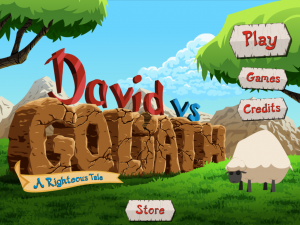 Well imagine my joy then when I discovered last week that the developers had actually made it to the finishing line and the game was available for download on the App Store – a serious feat in and of itself. And in terms of the quality of the game itself, it did not disappoint.
Well imagine my joy then when I discovered last week that the developers had actually made it to the finishing line and the game was available for download on the App Store – a serious feat in and of itself. And in terms of the quality of the game itself, it did not disappoint.
In my opinion, this game is in a league of its own as far as Bible-based games go, so it justifies a pretty substantial review. I’m going to tackle it as a game in its own right first – looking at the gameplay & graphics and so on – and then afterwards I’ll talk about how it handles the Bible. I’ll then wrap up with a bit of a conclusion.
Gameplay
I should be upfront and say that I’m not exactly the primary target audience of this game – it’s probably more geared towards 10 year old children than 31 year old men – so you should take what I say with a little pinch of salt, but I thought it was a genuinely fun game that I really enjoyed playing. If you’ve seen many other Bible-based games then you will know that this is high praise indeed – I didn’t even need to caveat that by saying “a genuinely fun game considering it was based on the Bible” – I can genuinely imagine that if I were a little younger then there’d be plenty to keep bringing me back to this again and again. When my son is a little older I’m sure we’ll have fun playing it together.
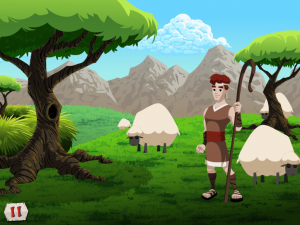 The main gameplay style is a bit of a hybrid between a hidden object game and a very simplified graphic adventure game. In any given scene there’s one particular character or object that will be highlighted that you tap to move the story on, but then there’s all sorts of hidden elements that you can tap on to unlock certain achievements – including the recurring character Spike, the loveable sheep who thinks he’s a dog who briefly pops his head up in various scenes throughout the game. These extra hidden items transform what might otherwise become a fairly dull gameplay mechanic into a really interesting experience, since there were plenty of scenes that I might want to replay again in the future to find the extra achievements that I didn’t manage to track down the first time through. That said, the story itself is told in a very engaging way, with plenty of humour to keep you hooked, so even people who aren’t interested in the extra achievements will still enjoy playing through it.
The main gameplay style is a bit of a hybrid between a hidden object game and a very simplified graphic adventure game. In any given scene there’s one particular character or object that will be highlighted that you tap to move the story on, but then there’s all sorts of hidden elements that you can tap on to unlock certain achievements – including the recurring character Spike, the loveable sheep who thinks he’s a dog who briefly pops his head up in various scenes throughout the game. These extra hidden items transform what might otherwise become a fairly dull gameplay mechanic into a really interesting experience, since there were plenty of scenes that I might want to replay again in the future to find the extra achievements that I didn’t manage to track down the first time through. That said, the story itself is told in a very engaging way, with plenty of humour to keep you hooked, so even people who aren’t interested in the extra achievements will still enjoy playing through it.
 The basic story is then interspersed with a number of mini games that tie in seamlessly with the plot. There’s a musical round where you have to copy the tune on David’s lyre to send the sheep to sleep. There’s a sideways scrolling round where David is chasing after a lion and you have to tilt the iPad backwards and forwards to dodge various obstacles. Once you’ve caught up with the lion there’s then a fight with the lion where you have to tap at the right time. And, inevitably, there’s various rounds of firing David’s slingshot at different targets, including the ugly giant Goliath.
The basic story is then interspersed with a number of mini games that tie in seamlessly with the plot. There’s a musical round where you have to copy the tune on David’s lyre to send the sheep to sleep. There’s a sideways scrolling round where David is chasing after a lion and you have to tilt the iPad backwards and forwards to dodge various obstacles. Once you’ve caught up with the lion there’s then a fight with the lion where you have to tap at the right time. And, inevitably, there’s various rounds of firing David’s slingshot at different targets, including the ugly giant Goliath.
Each of these mini games were good fun: challenging enough to be interesting, but with adjustable difficulty levels (and an option to skip altogether if you get stuck) so that they don’t get in your way if you just want to see where the story leads. I particularly enjoyed the lion chase – and knowing that there were some extra achievements to unlock if only I were a little more practised at it might just be enough to encourage me to go back to it again in the future.
Graphics, Animation & Music
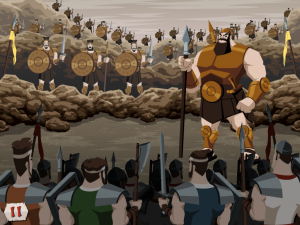 One of the standout features of this game is the sheer quality of the graphics and animation. The game looks gorgeous. The animation is beautifully done and really adds to the humour of the story. I don’t know a lot about the team behind the game, but they clearly know what they are doing.
One of the standout features of this game is the sheer quality of the graphics and animation. The game looks gorgeous. The animation is beautifully done and really adds to the humour of the story. I don’t know a lot about the team behind the game, but they clearly know what they are doing.
The music & sound production also deserve a mention. These work together with the animation flawlessly to really set the mood of the game. You can palpably feel the tension in the more dramatic moments of the story, particularly when the Philistines are first introduced, and as David marches out to meet his great foe.
The voice acting is also top notch and supports the humour of the script well.
Bible stuff – what I loved
So it’s clear that there’s much about this game that is brilliantly done – and not just “considering it was based on the Bible”. But of course, this game is based on the Bible – so how does it do on that front? On many levels, Righteous Tales does an awesome job of communicating the Bible story, so I’ll start by focussing on the best bits.
 The game does a fantastic job of getting beneath the skin of the story, and really helping to communicate the emotions of it all. An absolutely standout scene for me is when we meet the prophet Samuel, seeing how depressed he is thinking about all the ways that King Saul has failed to live up to the great hopes that Samuel had for him. The folks at Righteous Tales have clearly worked hard at grappling with this story and understanding what’s going on in each of the characters, and that hard work has really paid off.
The game does a fantastic job of getting beneath the skin of the story, and really helping to communicate the emotions of it all. An absolutely standout scene for me is when we meet the prophet Samuel, seeing how depressed he is thinking about all the ways that King Saul has failed to live up to the great hopes that Samuel had for him. The folks at Righteous Tales have clearly worked hard at grappling with this story and understanding what’s going on in each of the characters, and that hard work has really paid off.
As players we really get the principle of “man looks at outward appearances, but God looks at the heart”. This is communicated brilliantly through a talent show that each of David’s brothers fail in turn – for all their impressive appearances, they’re not the ones that God has chosen. Later in the game, you really get a sense for how terrifying the giant Goliath must have been, making the Israelites quake in their boots – and prompting Saul to offer all kinds of incentives to encourage somebody to fight Goliath so that he won’t have to. What’s especially brilliant is how the game makes it super clear that when Goliath taunts the Israelites, by doing so he is actually defying God himself – something which many treatments of this story seem to miss.
Goliath’s shield bearer is worth a mention – I love this character. He’s one example of the fantastic attention to detail shown throughout the game. Most people gloss over the shield bearer when reading the Biblical account of David & Goliath, but the fact that Righteous Tales have included him is clear evidence that they have been reading their Bibles extremely carefully. The result is a really fun and unique character that is incredibly memorable.
One thing that I’ve often grappled with when thinking about Bible-based computer games is whether or not to have a narrator. David vs Goliath does have a narrator, and I have to say, I think it really works. It makes it so much easier to communicate the meta-narrative when you have somebody who is outside of the story speaking into it, giving their commentary on how the characters feel and, more importantly, what God makes of the situation. It’s done with good humour, with David himself often interacting with the narrator, and helps put across the bigger picture rather than just the events themselves.
Bible stuff – what I wish were different
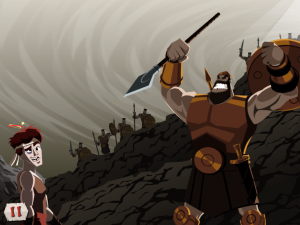 The story of David & Goliath is a bit of a litmus test for how people read the Old Testament. I think one of the most unhelpful ways of reading this passage is to make it entirely about me and whatever struggle I’m happening to face at the moment – “have enough faith and you can defeat the giants in your life too!” Personally, I think a much more helpful way to read it is to recognise who David is: God’s anointed future king who the Lord has raised up to deliver his people. We’re much more akin to the quaking Israelites who are completely unable to rescue themselves (something, by the way, which this game illustrates FANTASTICALLY well). Handily, Adam Ford has drawn a brilliant cartoon to communicate this much better than I ever could.
The story of David & Goliath is a bit of a litmus test for how people read the Old Testament. I think one of the most unhelpful ways of reading this passage is to make it entirely about me and whatever struggle I’m happening to face at the moment – “have enough faith and you can defeat the giants in your life too!” Personally, I think a much more helpful way to read it is to recognise who David is: God’s anointed future king who the Lord has raised up to deliver his people. We’re much more akin to the quaking Israelites who are completely unable to rescue themselves (something, by the way, which this game illustrates FANTASTICALLY well). Handily, Adam Ford has drawn a brilliant cartoon to communicate this much better than I ever could.
One commentator who I respect greatly, Dale Ralph Davis, writes this:
“If we don’t listen to this text, then we’ll end up bringing in all the junk about being courageous in the face of ‘your Goliaths,’ whether the bully down the street (for primary Sunday-school kids) or— everyone’s preoccupation— one’s poor self-image. We must protect ourselves from such deafness to the text.”
When I read on the Righteous Tales website “Walk with David as he demonstrates how to combine courage and preparation with God’s destiny for our lives to overcome all odds – even when no one believes in us!” I immediately leapt to the conclusion that this game had fallen into exactly the same trap that so many other treatments of David & Goliath have made over the years. However, after playing it I realise that they’re not actually applying it quite the way I thought they were going to. In fact, they take very much the same line as Dale Ralph Davis himself takes in his commentary: “Goliath is not merely the big goon from Philistia; Goliath’s blabbering dishonors Israel’s God… Hence in this chapter David essentially says to Israel and us: ‘Yahweh’s reputation is at stake; that matters to me; that matters enough to risk my life for it’” So it’s not taught in terms of David as a type of Christ, but rather as a faithful believer standing up for God’s honour in spite of his apparent weakness, when everybody around him is telling him that outward strength is all that matters and that the enemy is too great to stand up to.
I asked Gerald Hinson, one of the key figures behind Righteous Tales, about this. He said they made the decision not to major on the “David as a type of Christ” approach, knowing that just because it’s one way to read the passage doesn’t mean it’s the only valid way to read the passage. They did this partly because of the age of the target audience they had in mind and wanting to keep it simple for them, and partly out of a desire to try and tell the story as the Bible does in 1 Samuel, not as a modern commentator thinks it should be taught, trying not to improve on the Biblical account or make statements beyond those made in the text.
Personally, after my own work on 1 Samuel as part of my Bible-based game, I feel that the Old Testament context itself pushes us pretty hard to see David as teaching us about the deliverer we need, in anticipation of Jesus. Back in the very earliest chapters of the book, in Hannah’s prayer, we read “The Lord raises up the poor from the dust…to make them sit with princes” and “The adversaries of the Lord shall be broken to pieces” whilst “The Lord will give strength to his king” – in other words, the whole book is really about the kind of king God is going to raise up and how God is going to use him. In the original Jewish scriptures it was organised quite differently, so that 1 & 2 Samuel were combined together with 1 & 2 Kings to form 1, 2, 3 & 4 Kingdoms – a hint at Samuel’s role as “the King-Maker”. What’s more, I think passages like 1 Peter 1:10-12 would lead us to recognise that the Old Testament writers didn’t necessarily understand the full significance of everything they were writing, and that now the Spirit has come of course we should be reading the Old Testament through Jesus-tinted lenses.
So I would have loved to have seen us teed up a little more for some lessons about the kind of rescuer that Jesus was going to be. Done well, there’s really no reason this can’t be made accessible for kids – they get that “we need a king who trusts God, not like Saul who trusted in armour”. In the end I would say this is very much a “Bible-based game” rather than an explicitly Christian game, and I suspect that a Jewish player would enjoy David vs Goliath just as much as a Christian player. I can understand why they chose to do it this way, but I definitely found this rather disappointing.
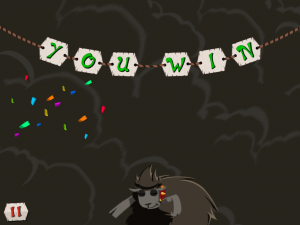 Another more minor quibble I had with the game is one I’ve talked about previously, which is the inherent challenge of translating a Bible story into a video game, where you tend to control the hero of the story. The final boss battle against Goliath is necessarily quite a tricky one – that’s what people expect from a video game, after all. When you finally succeed in killing Goliath you get a great big “You win!” celebration trumpeting your terrific skill in victory. This seems so at odds with the rest of the game that has worked so hard to make it clear that it’s not about us and our ability, and that David is fighting Goliath in God’s strength not his own. What’s so striking about the Biblical account of these events is that the battle doesn’t feel hard at all – in just a sentence or two David confronts Goliath, throws a single stone with his pathetic little sling, and – bam – the giant falls to the ground, dead. The focus in the Biblical account is entirely on God and very little on David.
Another more minor quibble I had with the game is one I’ve talked about previously, which is the inherent challenge of translating a Bible story into a video game, where you tend to control the hero of the story. The final boss battle against Goliath is necessarily quite a tricky one – that’s what people expect from a video game, after all. When you finally succeed in killing Goliath you get a great big “You win!” celebration trumpeting your terrific skill in victory. This seems so at odds with the rest of the game that has worked so hard to make it clear that it’s not about us and our ability, and that David is fighting Goliath in God’s strength not his own. What’s so striking about the Biblical account of these events is that the battle doesn’t feel hard at all – in just a sentence or two David confronts Goliath, throws a single stone with his pathetic little sling, and – bam – the giant falls to the ground, dead. The focus in the Biblical account is entirely on God and very little on David.
Conclusion
In “David vs Goliath”, Righteous Tales have really set the standard that all subsequent Bible-based games are going to have to live up to. It’s a genuinely fun game that really gets you beneath the surface of the Bible account and communicates the drama of the story wonderfully, including some truly memorable characters along the way. But ultimately, it leaves the story in the Old Testament with no reference to Jesus, making it more of a Jewish game rather than a Christian game.
It’s clear that Gerald and his team should be encouraged to keep making more games – and the best way we can do that is by buying this one (the basic game is free, although the full story is only unlocked through an in-app purchase) and by telling everybody you know to buy it too. But I hope and pray that as they do so, they will grow in their desire to point us forwards to Jesus.
Comments Closed
-
Categories
-
Articles
- July 2014
- June 2014
- January 2014
- March 2013
- March 2012
- February 2012
- January 2012
- October 2011
- August 2011
- July 2011
- June 2011
- April 2011
- March 2011
- February 2011
- January 2011
- December 2010
- November 2010
- June 2010
- May 2010
- April 2010
- March 2010
- February 2010
- December 2009
- October 2009
- August 2009
- July 2009
- June 2009
- May 2009
- March 2009
- February 2009
- January 2009
- November 2008
- August 2008
- March 2008
- January 2008
- December 2007
-
Meta





